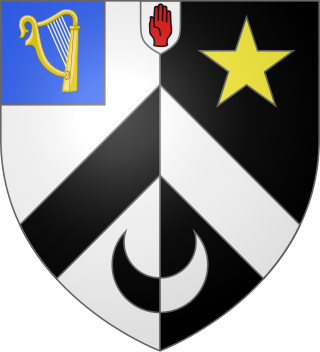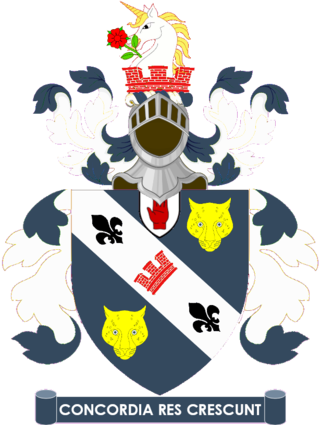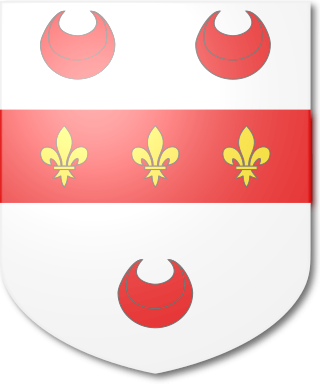The Ramsay baronetcy, of Balmain in the County of Kincardine, was created in the Baronetage of the United Kingdom on 13 May 1806 for Alexander Ramsay (surname at birth Burnett).
Alexander Burnett was the second son of Catherine Ramsay, the granddaughter of Sir Charles Ramsay, 3rd Baronet of Balmain of the earlier creation (1625) in the Baronetage of Nova Scotia, which was inherited by her brother, Sir Alexander Ramsay-Irvine, 6th Baronet. Catherine Ramsay married Sir Thomas Burnett of Leys, 6th Baronet, and their eldest son, Robert, inherited the Burnett baronetcy, while their second son, Alexander Burnett, was his maternal uncle's namesake and heir. Sir Alexander Ramsay, 6th Baronet bequeathed his estates to his nephew and the baronetcy was revived in favour of Burnett a few months after Sir Alexander's death, who changed his surname to Ramsay by royal licence. [1] [2]
The second Baronet sat as Member of Parliament for MP for Kincardineshire. The third Baronet was Member of Parliament for Rochdale. The seventh and present Baronet is the presumed heir to the dormant Burnett Baronetcy of Leys. [1]
William Alexander Ramsay, eldest son of Captain Francis Ramsay, third son of the second Baronet, was a brigadier-general in the British Army. His son Sir Bertram Ramsay was an admiral in the Royal Navy. [1]

The Eliott Baronetcy, of Stobs in the County of Roxburgh, is a title in the Baronetage of Nova Scotia. It was created on 3 December 1666 for Gilbert Eliott. The second baronet was a member of the pre-union Parliament of Scotland. The third Baronet sat as Member of Parliament for Roxburghshire. The Eliott Baronets share a common early Elliot ancestry with the nearby Earls of Minto (Elliot). It is thought that the surname spelling differences were contrived to differentiate the branches.

The Strachey baronetcy, of Sutton Court in the County of Somerset, England, is a title in the Baronetage of the United Kingdom. This family was originally seated at Walden, Essex, where William Strachey was living under the rule of Edward VI. Later they moved to Surrey and at last settled at Sutton Court, Somerset. The title was created on 15 June 1801 for the politician and civil servant Henry Strachey. Sir Henry was private secretary to Lord Clive during his last expedition to India in 1764. He also took part in negotiations for peace with North America where he assisted the kings commissioners at Paris. He died in 1809 and was succeeded by his eldest son Henry, the second Baronet Strachey. His great-grandson, the fourth Baronet, was a Liberal politician. On 3 November 1911, he was created Baron Strachie, of Sutton Court in the County of Somerset, in the Peerage of the United Kingdom. He later served as Paymaster General. The peerage became extinct on the death of his son, the second Baron, in 1973. The baronetage is currently dormant.

There have been two baronetcies created for persons with the surname Burnett, one in the Baronetage of Nova Scotia and one in the Baronetage of the United Kingdom. As of 2010 one creation is extant while one is dormant.

The Anstruther-Gough-Calthorpe Baronetcy, of Elvetham Hall in Elvetham in the County of Hampshire, is a title in the Baronetage of the United Kingdom.
The Adair Baronetcy, of Flixton Hall in the County of Suffolk, was a title in the Baronetage of the United Kingdom. It was created on 2 August 1838 for Robert Adair. He was succeeded by his eldest son, the second Baronet. He sat as Member of Parliament for Cambridge. In 1873 he was created Baron Waveney, of South Elmham in the County of Suffolk, in the Peerage of the United Kingdom. The barony became extinct on his death in 1886 while he was succeeded in the baronetcy by his younger brother, Hugh Adair, the third Baronet. The latter had earlier represented Ipswich in Parliament. Two of his sons, the fourth and fifth Baronets, both succeeded in the title. The fifth Baronet's son, the sixth Baronet, was a major general in the British Army. The title became extinct on the latter's death in 1988.

The Alexander, later Cable-Alexander Baronetcy, of the City of Dublin, is a title in the Baronetage of the United Kingdom. It was created on 11 December 1809 for William Alexander, Lord Mayor of Dublin. The second Baronet was a Director of the Bank of Ireland. The third Baronet was Attorney-General to Albert Edward, Prince of Wales, later Edward VII. The seventh Baronet assumed in 1931 by deed poll the additional surname of Cable. As of 31 December 2013 the present Baronet has not successfully proven his succession and is therefore not on the Official Roll of the Baronetage, with the baronetcy considered dormant.

The Baynes Baronetcy, of Harefield Place in the County of Middlesex, is a title in the Baronetage of the United Kingdom. It was created on 29 June 1801 for Christopher Baynes. He was Major-Commandant of the Uxbridge Gentlemen and Yeomanry Cavalry, which he helped to raise. The title descended from father to son until the death of his great-great-grandson, the fifth Baronet, in 1971. The late Baronet died unmarried and was succeeded by his first cousin, the sixth Baronet. He was the son of Reverend Malcolm Charles Baynes, fourth son of the third Baronet. As of 2023 the title is held by his grandson, the eighth Baronet, who succeeded his father in 2005.

The Bromhead Baronetcy, of Thurlby Hall in the County of Lincoln, is a title in the Baronetage of the United Kingdom. It was created on 19 February 1806 for the soldier Lieutenant-General Gonville Bromhead. His eldest son, the second Baronet, was a mathematician. He died unmarried and was succeeded by his younger brother, the third Baronet. He was a Major in the Army and fought at the Battle of Waterloo. His eldest son, the fourth Baronet, was a Colonel in the Indian Staff Corps. He was succeeded by his grandson, the fifth Baronet. He was a Lieutenant-Colonel in the Indian Army. As of 2007 the title is held by his son, the sixth Baronet, who succeeded in 1981. However he does not use his title.

The Feilden Baronetcy, of Feniscowles in the County Palatine of Lancaster, is a title in the Baronetage of the United Kingdom. It was created on 21 July 1846 for William Feilden, Member of Parliament for Blackburn between 1832 and 1847. He sat as a Liberal from 1832 to 1841 then as a Conservative from then until 1847.

The Oakeley Baronetcy, of Shrewsbury, is a title in the Baronetage of Great Britain. It was created on 5 June 1790 for the Indian administrator Charles Oakeley. He served as Governor of Madras from 1790 to 1794. Frederick Oakeley was the second son of the first Baronet.

The Couper Baronetcy is a title in the Baronetage of the United Kingdom. It was created on 23 June 1841 for George Couper. He was a colonel in the Army and fought in the Peninsular War, served as Military Secretary to the Governor Generals of Canada, Sir James Kempt and Lord Durham, and was Comptroller of the Household and Equerry to Her Royal Highness the Duchess of Kent. The second Baronet was an administrator in India and served as Governor of the North-West Provinces between 1877 and 1882. Another member of the family to gain distinction was James Kempt Couper, second son of the first Baronet. He was a general in the Army.
The Goold Baronetcy, of Old Court in the County of Cork, is a title in the Baronetage of the United Kingdom. It was created on 8 August 1801 for Francis Goold, with remainder to the heirs male of his father Henry Michael Goold, who gave valuable service to the government of King George III. The Goold family descends from William Gould, who served as Mayor of Cork during the reign of King Henry VII. His descendant George Gould changed the spelling of the surname to Goold. He was the father of Henry Michael Goold and the grandfather of the first Baronet.

The Muir Mackenzie Baronetcy, of Delvine in the County of Perth, is a title in the Baronetage of the United Kingdom. It was created on 9 November 1805 for Alexander Muir Mackenzie. Born Alexander Muir, he had assumed the additional surname of Mackenzie on succeeding to the estates of his great-uncle John Mackenzie, of Delvine, Perthshire, third son of Sir Kenneth Mackenzie, 1st Baronet, of Coul.

The Wedderburn, later Ogilvy-Wedderburn Baronetcy, of Balindean in the County of Perth, is a title in the Baronetage of the United Kingdom created in 1803.

The Farrington Baronetcy, of Blackheath in the County of Kent, is a title in the Baronetage of the United Kingdom. It was created on 2 December 1818 for General Sir Anthony Farrington, 1st Baronet.

The Fletcher, later Boughey Baronetcy, of Newcastle-under-Lyme and of Betley both in the County of Stafford, is a title in the Baronetage of Great Britain. It was created on 24 August 1798 for Thomas Fletcher, of Betley Court, Staffordshire, High Sheriff of Staffordshire in 1783 and 1789 and Deputy Lieutenant of the county. He was the husband of Elizabeth Fenton, granddaughter of George Boughey, of Audley, Staffordshire whose will provided for his great-grandson to inherit the Audley estate.

The Lynch of Galway – who later became Lynch-Blosse Baronetcy – is a Baronetage of Ireland title. It was created on 8 June 1622 for Henry Lynch, a member of an Anglo-Norman family and one of the merchant Tribes of Galway. Both he and the second Baronet represented County Galway in the Irish House of Commons. The third Baronet was a Baron of the Court of Exchequer (Ireland). Forced to flee to France after the Glorious Revolution, his eldest son succeeded to the title and estates. The family seat was Athavallie House, Castlebar, County Mayo. The sixth Baronet assumed the additional surname of Blosse, having married Elizabeth, daughter and heir of Francis Barker, heir of Tobias Blosse. The seventh Baronet also served in the Irish House of Commons representing Tuam.

The Buckworth, later Buckworth-Herne, later Buckworth-Herne-Soame Baronetcy, of Sheen in the County of Surrey, is a title in the Baronetage of England. It was created on 1 April 1697 for John Buckworth, High Sheriff of London in 1704. The second Baronet sat as Member of Parliament for Weobley. The third Baronet was Assistant Gentleman Usher to George II. The fifth Baronet was Gentleman-Pensioner and Exon of the Guard during the reign of George III. He married Anne, daughter of Paston Herne, of Haveringland Hall, Norfolk, and assumed by Royal licence the additional surname of Herne. The sixth Baronet assumed in 1806 by Royal licence the additional surname of Soame in compliance with the will of Sir Peter Soame, 4th Baronet, of Thurlow. The ninth Baronet was a member of the Shropshire County Council.
There have been three baronetcies created for personswith the surname Elphinstone, two in the Baronetage of Nova Scotia and one in the Baronetage of the United Kingdom. As of 2008 two of the creations are extant while one is dormant.

Rear-Admiral Sir William Ramsay KCB was a Scottish admiral in the Royal Navy.

















